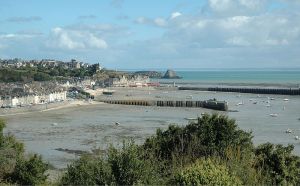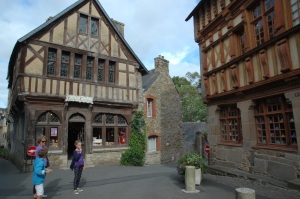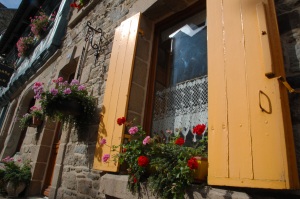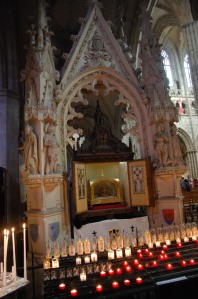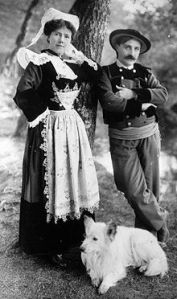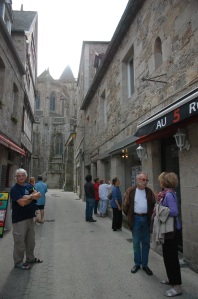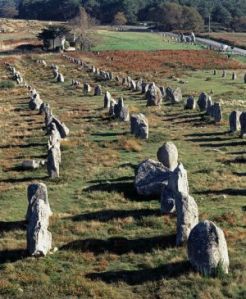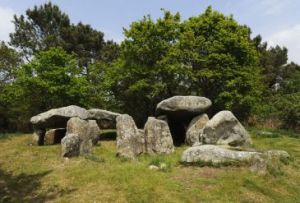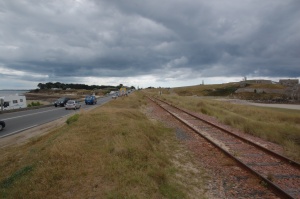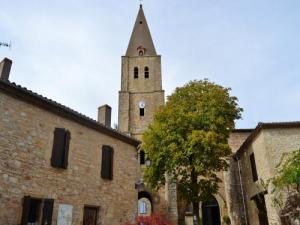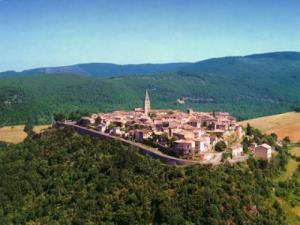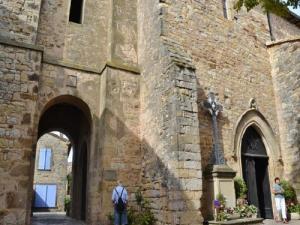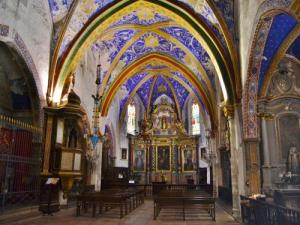We started with lunch in Cancale which is on a jutting-out peninsula not far from the lovely (I'm told) Saint Malo.
It was incredibly busy there so we found a fishy restaurant far away from the central streets, in a beautiful position overlooking the sea which was directly across the road. We kept placing bets as to how far the tide would go out, 'To that blue boat; to that buoy, no, to that fishing boat...' None of us were right, and it was still going out when we finished our lunch. We saw groups of friends on the beach prising open fresh oyster shells to squeeze in a squirt of lemon juice and then gulp the oysters down, chased by a glass of wine and some fresh French baguette. They looked so happy!
From there we made our way to Tréguier. I didn't really know what to expect of Tréguier but we had the name of the street where our friends' restaurant used to be, so off we went to climb rue Ernest Renan. (Tréguier is BEAUTIFUL. It is listed as one of the villages fleuris in France, which I take to mean: prettiest villages.)
Apparently, Tréguier is best known for being the birthplace of St Yves, the patron saint of lawyers, and Catholic lawyers from around the world have been known to make pilgrimages to Tréguier to pay homage. Well, we certainly weren't there for that purpose.
Our friends, Cathie and Stéphane (not in the photograph below...), now have a café in Wellington (Café Breton, no less), and on a wall in their café they have several black and whites photos of Tréguier quite some decades ago. People with wooden clogs on and strange but beautiful clothes (almost costumes), that sort of thing.
We searched high and low along rue Ernest Renan, up through the village, close to the cathedral, to find the site of Le Canotier. Nope, nothing. I asked in a tourist shop. No, never heard of it. I knew we were on the right street so I told my eight year old son that I was going to pop into a jewellery shop and ask if they knew of Le Canotier. As I stepped inside, Oliver pulled my arm and whispered, "Mum. Those people just there on the street are talking about the restaurant, and they're talking about New Zealand and our friends Cathie and Stéphane!"
Vraiment???! Of course, Oliver was listening to them speak in French.
I quickly walked up to them, smiling broadly and in my best French said, "My son said you were talking about New Zealand, and Cathie and Stéphane. They are friends of ours. We are from New Zealand. We want to find where their restaurant was." Ha ha ha, we all laughed. Quelle coïncidence. Then the nice Monsieur said, "Well, you are standing right in front of it." Turns out Monsieur and Madame were showing their visitors the site of the wonderful Le Canotier restaurant, opposite the jewellery shop, too. (Sadly it is now a real estate agent and a pizza place and not a popular, buzzing restaurant.)
We chatted for a while and found that Monsieur's father and Stéphane's father used to be great friends. Mission accomplished! Apparently Cathie and Stéphane's sister-in-law runs a charcuterie truck that sells yummy pate and anything in the pig line in the local markets. Her brand is 'Henriette'; so keep an eye out!
We then took a turn along winding country roads to find La Roche-Derrien, where C&S used to lived. Why oh why did they move to New Zealand? I cried as each turn in the road took us to more breath catching beauty.
Moving swiftly along, we took the coastal route around the Granite Coast (Trégastel, Perros-Guirrec, etc). Beautiful pinky rocks, rugged and wild seas, nothing like the long calm beaches of Normandy. This was raw, beautiful nature, like the west coast of New Zealand I thought. (read more about the Granite Coast on: http://www.francethisway.com/places/brittany-cote-de-granit-rose.php) From there we drove to our completely forgettable (preferably forgettable) cheap family accommodation for the night. That's all I'm saying about that.
Day two: let's see some menhirs and dolmen, and alignments (rows of standing stones)! This had been a big dream of mine since I starting reading Asterix and Obelix as a nipper. We knew the kids would like this, and we promised that we wouldn't drag them to any cathedrals. We went to 'The Carnac Alignments, an exceptional Neolithic site with 6,000 year old megaliths', so says the brochure. It's still all (educated) supposition as to why the alignments are there (sacred burial architecture vs ceremonial temples...), but they were continually constructed between the fifth and third millenia BC so something important was happening in the minds of those people for two millenia. Crikey. I've been inside an ancient dolmen (a stone table, sometimes with a burial passage underneath) in Ireland and it felt spookily the same to be in Carnac seeing/touching similar stuff.
Then with our brains a-whirring we headed towards Saint-Pierre-Quiberon, passing through and heading straight down the waist-thin peninsula to Quiberon itself. Another raw, lovely, fishy-restaurant-with-gorgeous-sea-views, heaving-with-tourists, quaint, delightful, completely unique village.
We ate lunch there, wandered a bit and headed to our much more comfortable (clean) family accommodation.
I really want to call Brittany 'Little Britain' but I know the name has already been taken by those two funny guys. For me, Brittany could be parts of England/Ireland/Wales as they look so similar. In fact, I've just had a look at Wikipedia and this is what I found:
Brittany is considered as one of the six Celtic nations, which are: Brittany (Breizh), Cornwall (Kernow), Ireland (Éire), the Isle of Man (Mannin), Scotland (Alba), and Wales (Cymru); and are territories in Northern and Western Europe. Each of these regions has a Celtic language that is either still spoken or was spoken into modern times, and their own cultural traits. Brittany has also been referred to as Less, Lesser or Little Britain (as opposed to Great Britain).So, not far off. I've been told that people in Wales who speak Welsh can understand French people in Brittany who speak Breton. Incredible. Some other striking things about Brittany are:
- the dish of the region is: galettes/crêpes and cider, while the dish of Normandy is moules et frites (mussels and french fries);
- in the north of Brittany you see slate tiles on the houses and people look more Anglo-Saxon; in the south of Brittany you see red Roman roofing tiles, and people with Roman noses!
- Brittany beaches are rugged and wild - like the south coast of Wellington, New Zealand. Normandy beaches are more similar to Auckland/Northland beaches. (Nice but strange to have a sense of New Zealand so far away,);
- the names of the towns/villages seemed to generally fall into different categories, for example: the 'Tré...' names (Tréguier, Trégastel, Trévé, Trémousen), the 'Plou...' names (Ploufragan, Ploumagaor, Plougonver, Plouisy, they go on and on), and the ones with the crazy apostrophes, like Ploumanc'h or the surnames Guivarc'h or Wrac'h. Hu'h???
